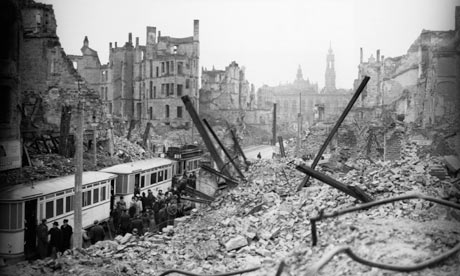This flurry of memorials discourages deeper analysis of the cost of war
The planned architectural folly celebrating the achievements of Bomber Command ignores its victims

Dresden after the bombing in 1945. Photograph: Bettmann/CORBIS
Several recently erected war memorials now litter the streets and parks of London, but they are of little intrinsic interest and zero artistic merit. A banal tribute to animals at the top of Park Lane;
an insipid celebration of women close to the Cenotaph in Whitehall, featuring overcoats on pegs;
belated memorials to the dead of Australia and New Zealand [BELOW] included within the large necropolis that now makes up the traffic island at Hyde Park Corner; and a meaningless Commonwealth gateway ("Memorial Gates" with no gates) at the top of Constitution Hill.
Now they are to be joined at the bottom of Piccadilly by a neo-classical architectural folly that celebrates the achievements of Bomber Command, to be opened by the Queen on 28 June.
Here the objection to the building is not so much its unadventurous design as the celebration that it implies of what are often perceived as British war crimes. Aerial bombing, the indiscriminate slaughter of civilians, women and children included, is one of the most vile legacies of the 20th century. Particularly as practised during the second world war, such bombing was always controversial and much contested at the time. For that reason it has taken more than half a century for the authorities to judge that the time is right to remember officially those who died.
Bomber Command is forever associated with the name of "Bomber" Harris, the officer in charge of "area bombing" during the war, and also a veteran of 20 years of colonial bombing in the nearer reaches of the British empire, beginning in Iraq. The British practice of bombing from the air was first widely used in the empire, starting withDarfur in 1916 and Somaliland, Egypt and Afghanistan in 1919. Iraq was bombed throughout the 1920s and the North-West Frontier of India throughout the 1930s. Aerial bombing continued after 1945 during the wars in Malaya and Kenya. Of course other European countries grew accustomed to bombing their natives too, such as the French in Syria and Morocco, the Italians in Libya and Ethiopia, the South Africans in Namibia. It is a disgusting and inextinguishable record.
Yet it is the bombing during the second world war that arouses most debate. Bomber Command liked to claim that it "successfully conducted operations designed to hamper the enemy's military and industrial capability in order to bring an end to the war". This, at best, is only a very partial truth. "Area bombing", as opposed to the "precision bombing" advocated by the Americans, meant the indiscriminate dropping of bombs over large areas with a huge deployment of planes and untold numbers of civilian casualties. The stated aim of Arthur Harris was to destroy German morale by killing the civilian population, and that meant not just industrial workers but women and children as well. An estimated 50,000 were killed in Hamburg on the night of 27 July 1943, and100,000, by some estimates, were killed in Dresden less than two years later, on 13 February 1945. These were war crimes. Their only possible justification is that the bombing may have hindered the German war effort elsewhere.
Voices of protest were heard at the time from the church, notably from George Bell, the bishop of Chichester, and from the Reverend John Collins, the chaplain at Bomber Command's headquarters (and later a prominent figure in the Campaign for Nuclear Disarmament). The clerics were not successful in their efforts to stop the bombing, but their vocal protests undoubtedly evoked a sense of unease, both within the political and military establishment and in the wider world. Bomber Command was tainted by the charge of committing war crimes, and its members were granted no special war medals. Bomber Harris refused his expected peerage in protest, and flounced off to self-imposed exile in South Africa.
At the end of the war, the British were in no mood to memorialise recent events. Most towns and villages were content to add names to the existing monuments to the fallen of the first world war. The extravagant Royal Artillery memorial from the 1920s at Hyde Park Corner
has a simple additional panel to commemorate the 30,000 who gave their lives in the second conflict "in all parts of the world".
Yet in recent years, perhaps because of the renewed enthusiasm for war and aerial bombing in the Blair years, the authorities have permitted a large amount of fresh memorialising, including the erection of a 20th century military memorial at the National Memorial Arboretum in Staffordshire, with the macabre inclusion of empty space to record 15,000 deaths still to come, in wars as yet unfought. Something similar happened in the Soviet Union, where only in the Brezhnev years did the Russians begin to expand their construction of monuments to their war dead. The new Bomber Command memorial appears to fit into this pattern.
What is lacking with all these new monuments is any kind of historical and educational re-assessment of what all this sacrifice amounted to, or what was involved in terms of the moral degradation of the country. "Even today," writes Sven Lindqvist in his indispensable book, A History of Bombing, "there is no hint in any British museum of the systematic attacks on German civilians in their own homes. No hint that these attacks constituted crimes against international humanitarian law for the protection of civilians." We prefer to build innocuous memorials rather than museums that might reflect on the huge cost of past battles, not just to "the glorious heroes" on our side but to the uncounted innocent peoples with whom we were once in conflict.
-------------------------------------------

NZ's memorial slammed as worse than Australia's 'urinal' (+photos)
11:47 AM Thursday Feb 14, 2008
[1]
[2]
New Zealand's war memorial in London has been criticised as "bristling" and "unlovely"[1] and more offensive than its Australian equivalent [2] in a campaign against tasteless, poorly-executed public artworks in the city.
Tim Knox, director of Sir John Soane's Museum in London, told The Timesnewspaper that many modern sculptures and other artworks in the city were "horrors" and "Frankenstein monster memorials".
"In the Victorian era and in the early 20th century there was great confidence and world-class artists were used," he said. "'But today that confidence has gone and the sculptors are not the world's best. This free-for-all needs to be regulated and I'm worried about the sheer proliferation of these Frankenstein monsters." His concerns were echoed by art historians, and museum and gallery experts.
Richard Shone, editor of The Burlington Magazine and an art historian, also complained of the infestation of public places by statues and memorials.
He said the Australian war memorial (click here for photos), despite resembling a urinal, was much less offensive than its nearby New Zealand equivalent - which was a "bristlingly unlovely installation in one of the most public sites in London".
"The New Zealand one seems to me very bad, the black spikes sticking up seems very aggressive ... the war is over!"
The New Zealand War Memorial - known as The Southern Stand - consists of 16 cross-shaped slabs of bronze up to 4.5m high and weighing up to 700kg. It carries New Zealand motifs: a fern leaf, a rugby ball, a figure, a farmer and Anzac poppies, with some of the stands laid out to resemble the Southern Cross constellation. It was designed by John Hardwick-Smith and Paul Dibble and was dedicated by Queen Elizabeth II on November 11, 2006.
The memorial is said to commemorate "enduring bonds" between New Zealand and Britain, and their shared sacrifice during times of war.
The Australian memorial, meanwhile, was designed by Sydney-based architectural firm Tonkin Zulaikha Greer in association with artist Janet Laurence and was unveiled by Queen Elizabeth II on November 11, 2003.
It is in the form of a long curving wall of Australian granite, with falls of water, and is set with the names of the 24,000 home towns of Australian men and women who served during the two world wars.
The names of 47 battle grounds are superimposed over the town names, which are intended to reflect the impact of the casualties on their families and communities.
"It's not so bad, but again, I wonder if it's the right place for it, where people are rushing past and don't have time to read it," Shone said.
"It also obscures certain views in that area, the New Zealand one even more so."
Westminster City Council told The Times it was concerned about the proliferation of statues and memorials on its streets - now more than 300.
It is stipulating that someone can only be commemorated in bronze or stone if they have made a serious contribution to society.
- NZPA / AAP
----------------------------





_18.jpg)



No comments:
Post a Comment